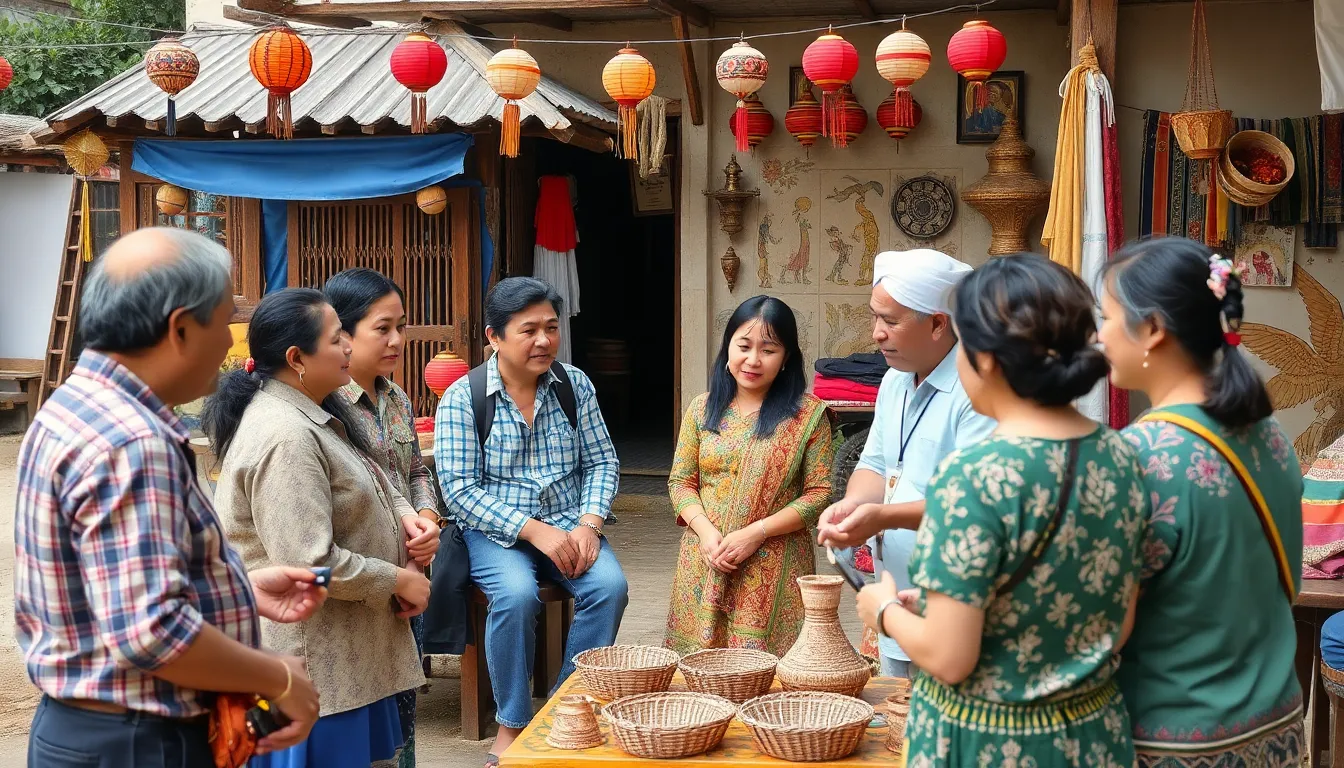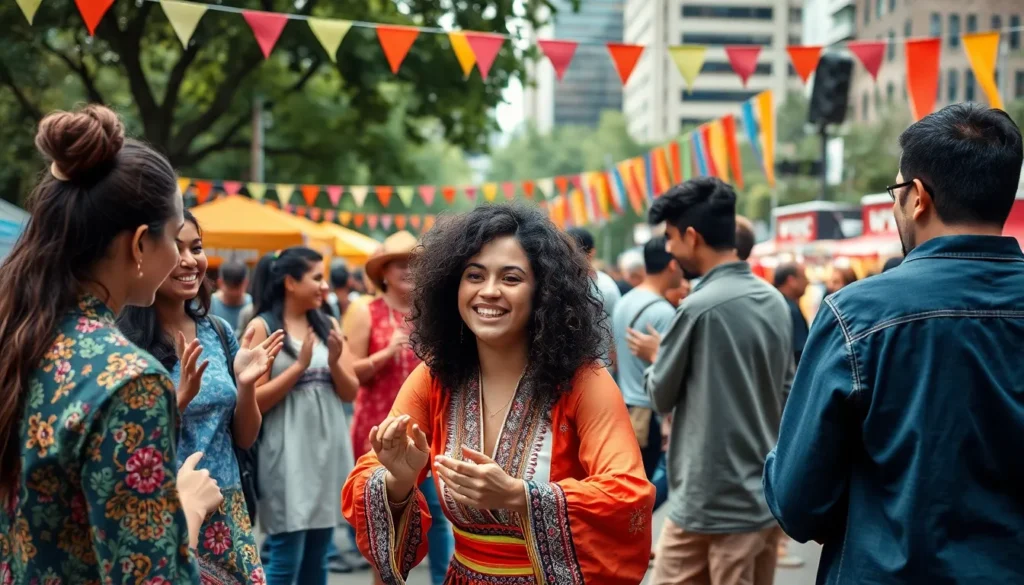Cultural observation isn’t just a fancy term for people-watching; it’s the ultimate backstage pass to understanding the quirks and nuances that make societies tick. Imagine diving into a world where every gesture, food choice, and fashion statement tells a story. It’s like being a detective in a vibrant, living museum, where the exhibits are real people and their everyday lives.
Whether it’s the way a group shares a meal or how they celebrate their traditions, cultural observation opens a window to insights that can enhance everything from travel experiences to global business strategies. So grab your metaphorical magnifying glass and get ready to uncover the fascinating layers of human behavior that shape our world. Who knew learning about cultures could be as entertaining as binge-watching your favorite series?
Table of Contents
ToggleUnderstanding Cultural Observation
Cultural observation serves as a critical tool for grasping the complexities of various societies. This practice allows individuals to gain deep insights into the daily lives and behaviors of different cultures.
Definition and Significance
Cultural observation refers to the systematic study of people and their behaviors within their environments. It helps uncover values, traditions, and social norms that define a community. Understanding these elements aids in promoting tolerance and appreciation of diversity. Improved cultural insight can enhance communication among groups and inform strategies in fields like marketing and international relations. It enriches the travel experience by offering authentic engagement with local customs. Cultural observation plays a vital role in fostering empathy and bridging cultural gaps.
Methods of Cultural Observation
Several methods facilitate effective cultural observation. Participating in local events allows observers to engage directly with cultures. Ethnographic studies provide comprehensive insights through first-hand experiences. Informal conversations with locals offer personal narratives that highlight specific cultural aspects. Visual documentation, such as photography or video, captures moments that reflect societal values. Additionally, journal reflections encourage observers to process and analyze experiences. Surveys and questionnaires gather quantitative data on cultural practices, contributing to broader understanding. Each method provides unique insights, enriching the observer’s comprehension of a culture.
The Role of Cultural Observation in Research


Cultural observation plays a critical role in research by providing insights into the complexities of human behavior and societal structures. This method enhances understanding and engagement with diverse communities.
Qualitative vs. Quantitative Approaches
Qualitative approaches focus on deeper insights through open-ended interactions, capturing emotions and motivations. Ethnographic studies exemplify this, revealing rich narratives and fostering empathy. In contrast, quantitative methods emphasize numerical data and statistical analysis, enabling researchers to identify patterns across larger groups. Surveys and structured interviews often gather these statistics. Both approaches complement each other; qualitative data can inform hypotheses that quantitative analysis tests, creating a holistic view of cultural phenomena.
Ethical Considerations
Cultural observation carries significant ethical implications. Researchers must ensure respect for participants’ privacy and cultural norms while observing behaviors. Informed consent is paramount; participants must understand the purpose and potential impact of the research. Balancing observational insights with ethical responsibilities fosters trust and rapport with communities. Additionally, researchers should be aware of potential biases, aiming for an impartial perspective. Respecting cultural sensitivities enhances research integrity and promotes mutually beneficial relationships.
Applications of Cultural Observation
Cultural observation finds applications across various fields, enriching understanding and promoting informed strategies.
Anthropology and Sociology
Cultural observation plays a crucial role in anthropology and sociology. It provides insights into human behaviors and societal structures. Researchers utilize qualitative methods to gather in-depth data about cultural practices and social norms. Observations during community rituals or daily activities reveal how individuals and groups interact. Such approaches cultivate an appreciation for diversity, fostering empathy among different cultures. Ethnographers often immerse themselves in communities, documenting behaviors through participant observation. This immersive strategy enhances their understanding of complex cultural dynamics, enriching academic discourse and contributing to the body of knowledge in these disciplines.
Business and Market Research
In the realm of business and market research, cultural observation serves as a powerful tool. Companies leverage observations to grasp consumer behaviors and preferences. Understanding local customs enables brands to tailor products to specific markets, enhancing relevance. Observing interactions in retail environments provides insights into decision-making processes. This data drives marketing strategies and product development, promoting deeper connections with target audiences. Businesses employing cultural observation can anticipate trends, positioning themselves ahead of competitors. By being attuned to cultural shifts, organizations enhance their capabilities to deliver meaningful experiences to consumers.
Challenges in Cultural Observation
Cultural observation presents various challenges that can hinder the accuracy and depth of insights gained. Addressing these challenges ensures more effective understanding.
Bias and Subjectivity
Bias and subjectivity often cloud the observer’s judgment. Personal experiences and backgrounds shape interpretations of cultural behaviors. Observers might unintentionally project their own values onto different practices, leading to misinterpretations. Recognizing and reflecting on inherent biases helps mitigate this issue. Using multiple perspectives adds balance, promoting a more comprehensive understanding. Creating an environment that encourages open dialogue enables deeper insights from diverse viewpoints. Engaging with local voices also offers clarity, enriching the observer’s analysis of cultural phenomena.
Navigating Cultural Differences
Navigating cultural differences poses another challenge in cultural observation. Each culture has unique norms and values that may not align with one’s own. Misunderstandings can arise from language barriers, body language, or specific social customs. Observers should approach interactions with an open mind. Building rapport with community members fosters trust, paving the way for authentic exchanges. Listening actively and observing non-verbal cues enhances communication and understanding. Adapting strategies to respect cultural nuances leads to richer observational experiences. Emphasizing patience during encounters helps bridge gaps between cultures, resulting in deeper connections.
Cultural observation serves as a vital lens through which individuals can appreciate the richness of diverse societies. By immersing themselves in different environments and engaging with local customs, observers can uncover valuable insights that enhance their understanding of human behavior. This practice not only fosters empathy but also promotes a greater appreciation for the complexities of cultural identities.
As cultural observers navigate the challenges that come with this endeavor, they develop a deeper connection to the communities they study. Ultimately, embracing cultural observation can lead to more informed interactions and strategies across various fields, enriching both personal experiences and professional practices.





